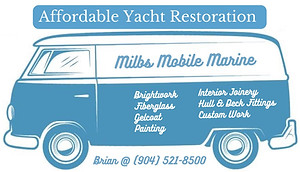
9610 Commonwealth Ave., Jacksonville, FL 32220
Removal of Backstay Padeye Bolt, Aft Deck Repair, and Interior Sanding (1-15-25)
Jan 15, 2025
When Biscuit arrived at the shop, the taff rail had already been removed, along with all of her brightwork save for the toe and rub rails. This CD Typhoon's owner was intent on restoring her, but his busy schedule would not allow. In the effort to remove the backstay's padeye and taff rail, one of the 1/4" bronze machine screw heads snapped off. I had previously attempted a quick removal by vice grips, but quickly aborted the effort thinking I would just return to it later. Today seemed an appropriate time to revisit the effort. My attempt was to wind on a couple 1/4" nuts, and then remove the lower nut, and compress it into the upper nut. My thinking was that the now locked together nuts would spin the machine screw up and out. No luck, she sheared off just below the lower nut. Nothing to do now but get invasive!
With a small 3/4" hole saw, I drilled down roughly 1/2" and with a flathead screw driver removed the material just around the machine screw stub. What I noticed in this small extracted area was that no balsa core was visible. My plan was to glass in some G-10 material, and then tying in a larger surrounding area with 1708 biaxial fiberglass cloth. With an oscillating tool, I set out to remove a portion of the deck to a sufficient depth to allow the G-10 to be glassed in. What I found, however, was the area was solid glass. I placed a camera into the space beneath the aft deck to confirm what I was seeing from above, gaining access through the inspection plate in the cockpit's aft bulkhead. I could see what appeared to be a solid fiberglass backing plate and a lot of squeezed out polyester, or vinylester, thickened resin - serving as a hull to deck joint glue. Back up on the deck, I altered my plan to the application of two layers of 1708 biaxial. With the small Makita 1" belt sander, I removed sufficient material on the inner portion of the repair and then widened the grinding to accept a larger piece of 1708 cloth to tie the repair together.
Prior to laying glass on the deck, I wanted to bring some additional structure to the underside of the deck - where the balsa core transitioned into the solid glass. Through the small inspection plate opening, I hand-sanded the targeted area with 80-grit sanding disks. I attempted to shimmy my way aft on the port quarter berth, and I've done this very thing on two different CD Typhoon repairs in the past, but to no avail. This Typhoon just simply did not provide the space needed to inch-worm my body back there. I stayed at the hand-sanding work for a good while to ensure I created a surface for good mechanical bonding. I then solvent-washed the area and prepped for thickened epoxy. Back in the shop, I mixed a batch of epoxy and thickened it with 404 high-density filler. I applied a good amount to the targeted area, filling in the transition from cored deck to non-cored deck. I also applied this thickened epoxy to the existing machine screw holes and any rough gouges or voids - the new fasteners for the backstay padeye would need to be drilled and tapped regardless and so I was more interested in creating a sound substrate for the mounting of the padeye.
With the thickened epoxy applied, I turned my attention to wetting out the glass, laying it in place and removing trapped air, and finally applying peel ply. More to come on this repair. With the balance of my time, I sanded the interior liner repairs using both hand and machine.
Total Hrs: 4.5








